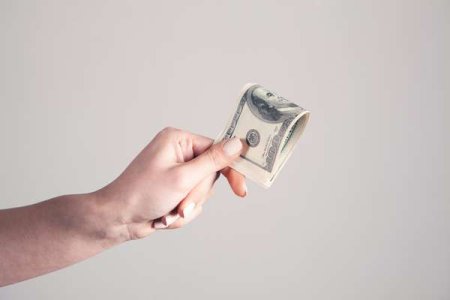This clever money hack seems perfect, but eagle-eyed viewers have uncovered a major flaw!
- Replies 0
We all love a good life hack—something that makes everyday decisions effortless while helping us keep a little extra cash in our pockets.
Whether it’s shopping smarter, stretching your budget, or finding an easy way to calculate costs, we’re always on the lookout for tricks that promise to make things simpler.
But what if one of those so-called money-saving shortcuts is actually making you spend more without realizing it?
Alex Newnam, a social media user with over 180,000 followers, recently shared a quick and easy way to calculate a tip—no calculator needed.
In her video, she demonstrates a basic math hack to leave exactly 20% without the hassle of crunching numbers.
Her method? Move the decimal point one place to the left to find 10% of your total, then double it to get 20%.
For example, if your bill is $64.93, shifting the decimal gives you $6.49, which represents 10%. Doubling that would bring you to $13, making tipping simple and stress-free. Sounds great, right?

While the trick seems like a no-brainer, commenters were quick to point out a major flaw—Alex’s method calculates the tip based on the post-tax total, rather than the pre-tax subtotal.
And why does this matter? Because tipping on the tax means you’re paying extra for no reason.
Many argue that tips should be based on the actual cost of the food and service, not the government’s share of the bill.
"Don't tip off the total as that includes tax. You tip off the subtotal," one viewer pointed out.
"Why would you tip on the tax??" another added.
In fact, service workers are taxed on their tips, meaning that tipping on the post-tax amount doesn’t benefit them—it just inflates your bill.
Of course, this sparked a larger debate about tipping in general. Some believe that tipping 20% is too generous for simply bringing food to the table, arguing that 15% used to be the norm.
Others, however, stand by the 20-25% rule for great service, with some tipping even higher for exceptional experiences.
And then there are those who admitted they don’t tip at all, saying, "I put a zero on the tip line."
Clearly, tipping is as much about personal preference as it is about etiquette.
Source: Alex Newnam / TikTok
This viral hack is a perfect example of why small calculations matter, especially when they become routine habits.
A slight miscalculation here or there might not seem like much, but over time, it adds up.
Looking for more ways to keep extra cash in your pocket? Check out these genius money-saving tricks that could slash your bills instantly!
 If you’ve already gotten your hands on this much-talked-about dessert, we want to hear from you! Are you on board with the hype, or are you waiting for a different sweet surprise to steal the spotlight? Drop your thoughts in the comments below!
If you’ve already gotten your hands on this much-talked-about dessert, we want to hear from you! Are you on board with the hype, or are you waiting for a different sweet surprise to steal the spotlight? Drop your thoughts in the comments below!
Also read: Slash your energy bills by 40% with this genius washing machine hack—find out when to use it!
Whether it’s shopping smarter, stretching your budget, or finding an easy way to calculate costs, we’re always on the lookout for tricks that promise to make things simpler.
But what if one of those so-called money-saving shortcuts is actually making you spend more without realizing it?
Alex Newnam, a social media user with over 180,000 followers, recently shared a quick and easy way to calculate a tip—no calculator needed.
In her video, she demonstrates a basic math hack to leave exactly 20% without the hassle of crunching numbers.
Her method? Move the decimal point one place to the left to find 10% of your total, then double it to get 20%.
For example, if your bill is $64.93, shifting the decimal gives you $6.49, which represents 10%. Doubling that would bring you to $13, making tipping simple and stress-free. Sounds great, right?

Precision in small calculations leads to greater accuracy. Image source: Sasun Bughdaryan / Unsplash
While the trick seems like a no-brainer, commenters were quick to point out a major flaw—Alex’s method calculates the tip based on the post-tax total, rather than the pre-tax subtotal.
And why does this matter? Because tipping on the tax means you’re paying extra for no reason.
Many argue that tips should be based on the actual cost of the food and service, not the government’s share of the bill.
"Don't tip off the total as that includes tax. You tip off the subtotal," one viewer pointed out.
"Why would you tip on the tax??" another added.
In fact, service workers are taxed on their tips, meaning that tipping on the post-tax amount doesn’t benefit them—it just inflates your bill.
Of course, this sparked a larger debate about tipping in general. Some believe that tipping 20% is too generous for simply bringing food to the table, arguing that 15% used to be the norm.
Others, however, stand by the 20-25% rule for great service, with some tipping even higher for exceptional experiences.
And then there are those who admitted they don’t tip at all, saying, "I put a zero on the tip line."
Clearly, tipping is as much about personal preference as it is about etiquette.
Source: Alex Newnam / TikTok
This viral hack is a perfect example of why small calculations matter, especially when they become routine habits.
A slight miscalculation here or there might not seem like much, but over time, it adds up.
Looking for more ways to keep extra cash in your pocket? Check out these genius money-saving tricks that could slash your bills instantly!
Key Takeaways
- A TikTok user shared a viral math trick that seemed like an easy way to quickly calculate an amount without using a calculator.
- Viewers quickly spotted a flaw—the trick uses the total bill, including tax, rather than the subtotal, which could lead to unintentional overspending.
- The viral discussion turned into a broader debate, with users weighing in on how much people should actually be spending.
- Always double-check shortcuts, because small calculation mistakes can add up over time.
Also read: Slash your energy bills by 40% with this genius washing machine hack—find out when to use it!






